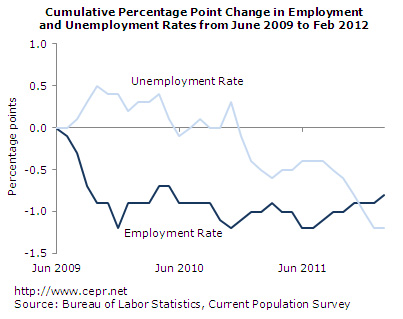Fact-based, data-driven research and analysis to advance democratic debate on vital issues shaping people’s lives.
Center for Economic and Policy Research
1611 Connecticut Ave. NW
Suite 400
Washington, DC 20009
Tel: 202-293-5380
Fax: 202-588-1356
https://cepr.net
March 9, 2012 (Jobs Byte)
By Dean Baker
The employment-to-population ratio is 0.4 percentage points above its low for the cycle.
The employment-to-population ratio (EPOP) edged up to 58.6 percent in February, its highest level since May of 2010, as the Labor Department reported that employers added 227,000 jobs in February. With upward revisions to the prior two months’ data, average job growth over the last three months is now reported as 244,000.
Job gains were concentrated in a relatively small group of industries. The employment services industry (which includes temps) added 61,100 workers in February. The industry has now added 165,000 workers over the last four months. While this is often taken as a harbinger of more rapid growth in permanent jobs, that is not always the case. In the period from November 2009 to February 2010, the industry added 176,800. There was no subsequent uptick in private-sector employment.
The other sectors showing unusually large gains were health care (49,000 jobs), restaurants (40,800), and durable manufacturing (31,000). The gains in health care were extraordinary, especially since they followed reported growth of 43,300 in January, the largest two-month gain on record. If this pace is sustained, then it would appear that efforts at cost control in health care are not working. The growth in restaurant employment was probably helped by an unusually warm February.
The rise in manufacturing employment was impressive; with upward revisions to the prior two months, the sector has added 111,000 jobs over the last three months. The auto industry has been a driving force, directly accounting for 20,700 of these jobs. The pace of growth may slow, but it seems likely that manufacturing will be a major force in the recovery going forward.
Another positive sign was a rise of 10,200 (0.8 percent) in trucking jobs. That could suggest a lot more goods being transported; although it could just be a seasonal anomaly since we reportedly added 12,400 trucking jobs last February. Retail reportedly lost 7,400 jobs after gaining 26,100 last month. This is clearly a seasonal adjustment issue as department stores reportedly added 25,900 jobs in January and lost 25,000 this month.
One very positive sign is that state and local government added 1,000 jobs after adding 7,000 last month. This indicates that the sector will no longer be a drag on growth and could even provide some modest boost over the course of the year. On the negative side, wage growth may be weakening, with the hourly wage rising at just a 1.4 percent annual rate over the last quarter.
The gains on the employment side appear to have disproportionately benefited African Americans. Their EPOP edged up just 0.1 percentage point in February, but is 1.2 percentage points above its December level and 2.1 percentage points above the low reported for the downturn last summer. However, the current level of 53.0 percent is still 6 percentage points below the pre-recession level. The EPOP for black teens is up 4.4 percentage points from its low last summer.
Employment growth continues to be concentrated among older workers, with people over age 55 accounting for 277,000 of the 428,000 growth in employment reported in February in the household survey. By education level, college grads were the big winners with their EPOP jumping by 0.7 percentage points, although most of this was reversing an erratic drop of 0.5 percentage points reported in January. The EPOP for high school grads fell by 0.5 percentage points to 54.1 percent, a new low for the downturn. Most likely this is also an anomaly.

Other good news in the household survey includes an increase in the portion of unemployment attributable to people voluntarily quitting their jobs and a fall in all the measures of unemployment duration. In another likely anomaly, the number of self-employed workers fell by almost 300,000 to the lowest level since May of 1992.
On the whole this report provides further evidence that the economy is on a steady growth path. Unusually good weather has likely boosted employment in the last three months, which means that future growth will be slower. Still, a pace of 200,000 jobs a month seems likely. However this is hardly cause for celebration; at this rate the economy will not make up the shortfall in jobs until the end of the decade.